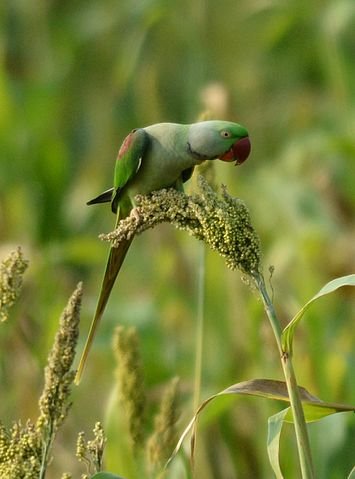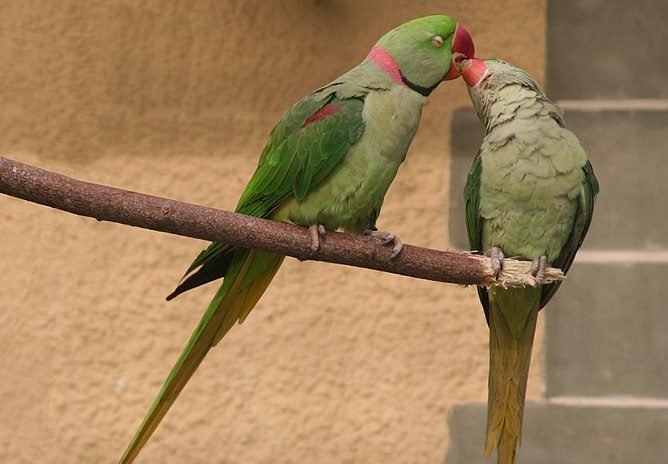Be it that you’re looking for a first-time pet or that you’ve been a long-term parrot parent, Alexandrine parakeets account for one of the best suitable bird species for captivity.
If you want to learn more about the diet of an Alexandrine Parakeet, including all about their native eating habits and what you can feed them at home, then keep on reading this article in which we tell you all about the dos and don’ts.
Alexandrine Parakeet diet in the wild
This specific species of parrot originally comes from the tall and dense forest lands of Sri Lanka and India, although nowadays you can find them in many different countries in Europe and the Mediterranean region.
When in the wilderness, they like to feast on herbs commonly found in the woods and on agricultural land. However, they are omnivores by nature.

They will take a bite out of the occasional insect here and there for protein, but they prefer to eat seeds, nuts, fruit, flowers, and nectar while corn is a special delicacy for this species. Due to this, some rural areas that host wild Alexandrine Parakeets even deem them as a pest, as they compensate for gathering food by stealing crop seeds. When they have the opportunity to switch up meals, they do so with pleasure.
Ultimately, these parrots eat almost anything. Their food options will greatly reflect their general well-being. Alexandrine parrots usually live around 20 years, but parrots kept in captivity given a large variety of fresh food are able to live up to 30 years of age (and even longer than that in some instances).
Alexandrine Parakeet diet in captivity
Because Alexandrine Parakeets are so used to eating a large variety of different food items from different food groups, they should have an extensive meal plan in captivity with lots of options to choose from. Some of these are:
- Seeds and nuts
Alexandrine Parrots really enjoy their seeds, so there’s no reason to remove them from the routine. Most pet shops and grocery stores offer basic Parakeet seed mixes that you can’t go wrong with. Adding some additional seeds, like i.e. sunflower seeds, is a good way to boost the nutritional value, as well as adding some nuts such as walnuts, hazelnuts, and almonds. Don’t go overboard on the nuts – as they are high in calories and might result in obesity and overindulging. - Pellets
Starting off with the most common food choices, Pelleted Parrot mixes are a great way to add a high-nutritional routine to your Parakeet’s diet. Alexandrine Parakeets can be picky eaters – some prefer to eat dry food and seeds, which won’t provide them with the necessary vitamins and minerals. A pellet-only diet is generally healthier for your bird than a diet made entirely out of seed mixes. A parrot that already likes to experiment with food does not need pellets, but you can keep them on hand for variety and for days when you might not have much else to offer. - Whole grains
You can add whole grains that you yourself snack to your parrot’s diet, such as popcorn, crackers, wheat pasta, brown pastry, oatmeal, quinoa, buckwheat, and wild rice. Opt for things made of complex carbohydrates, and avoid processed sugar and seasoning. Too much salt can be toxic to parakeets, so it’s genuinely better to buy organic oats and grains if you want to share them with your feathery friend. If your parrot is not a lover of fruits and veggies, this is a great alternative for a healthy source of energy. Of course, don’t forget to treat them with corn every now and then. - Fruits and vegetables
Always opt to give at least a little greens to your parrot in order to keep their digestion going. You can sprout seeds if you’re dealing with a stubborn little bird, but if they’re open for experimenting, you can give them kale, zucchini, cucumber, and radish.
They can also have carrots, broccoli, asparagus, potatoes, cauliflower, beans, and lentils, but make sure that you cook them first as you would for yourself – again, avoid seasoning! Berries are a nice dessert option, but you can also give them apples or mango cut into bite-sized pieces, or even in shredded form. They also love to nibble on a banana from time to time. - Meat and dairy
As stated before – Alexandrine Parakeets are omnivores, and when in nature – they like to hunt for worms and insects when they crave more protein. They can eat almost any kind of meat as long as it’s cooked properly (and, to repeat – unseasoned). Avoid canned fish if it’s soaked in oil. When it comes to dairy, it could actually be beneficial in smaller amounts, especially yogurt as it is also a probiotic. Avoid milk at any cost, they do not tolerate raw milk at all.
What food to avoid
Although Alexandrine Parakeets can eat a large variety of different foods, there are still some precautions that you need to have on mind, such as;
- Avoid raw beans, lettuce, and cabbage as they can cause bloating which could be very harmful to your parrot.
- Although they like pastry and pasta very much, opt for complex carbohydrate options, as plain, white bread and noodles are very high in processed sugars. Speaking of which – avoid processed sugars and candy altogether, as well.
- Onions, onion powder, garlic, chives… these are all toxic to many animals, yet alone parakeets. Small doses could be life-threatening.
- Remove any seeds from the fruit you cut, such as apples and pears, as they are very acidic and potentially toxic.
- Caffeine and any other stimulants should be kept out of reach of your Parakeet.
Additional tips
If you want to be a little extra with the way you handle your parrot, you can do the following;
- Add a colour variety to their meals. Instead of giving them seeds in the morning, berries in the afternoon and veggies in the evening, you can combine all textures and flavours into one bombastic dish. Alexandrine Parakeets absolutely adore colourful food, so this could make their feeding time a little more exciting. This is also one of the many reasons as to why pellets are attractive to most parrot breeds.
- Cuttlebone is your parrot’s best friend. It has a texture that almost all parrots enjoy, it’s a great way for them to trim their beak on their own, and it’s a great source of calcium and other necessary minerals to keep your parakeet active and happy.
- Instead of adding a daily dose of seed mixes in a bowl, try buying seed-based treats like cracker sticks. You can also make your own at home by mixing a little bit of banana and honey and dipping it into seeds, nuts and oats.
Alexandrine Parakeets are very affectionate birds. The more attention you give them, the more they give back. They are known for establishing close relationships with their human caretakers. If you make your parrot excited about feeding time, rest assure that your bond will become stronger day by day.
Read more about Alexandrine parrot Breeding
https://parrotquaker.com/alexandrine-parrot-breeding/
Featured image Credit: Dr. Raju Kasambe




